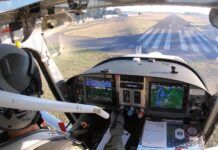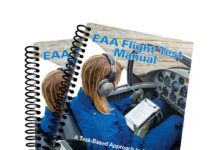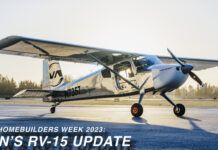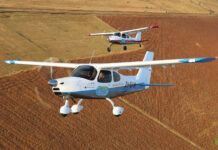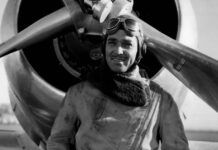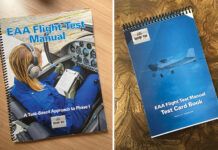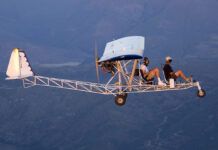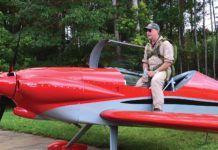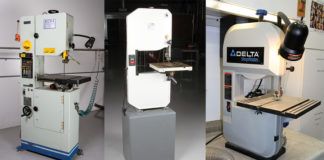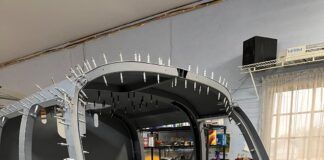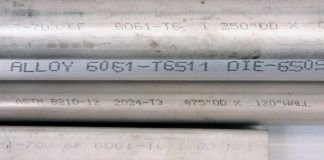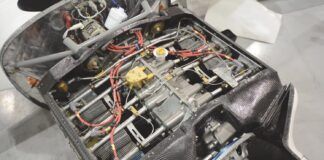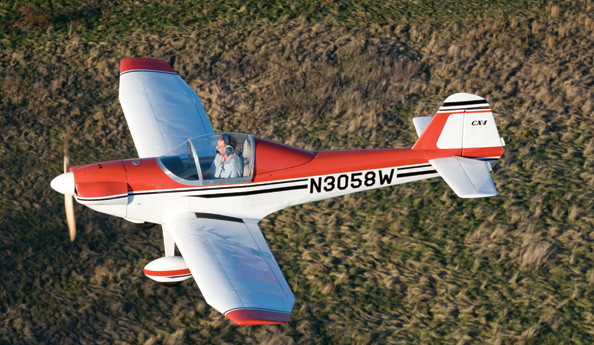
 Most of us have a fantasy. It involves an idealized airplane—simple, good looking, handles well. It should be fun to fly with no pressure to go fast, and without the need to travel far. It could be a single-seater, even—a selfish aeronautical experience. Oh, and it needs to be inexpensive, and it absolutely should be LSA legal so that one can fly it as long as ability allows. For this mission, the Thatcher CX4 is just right, with gentlemanly handling, but a price and looks that may appeal to both younger and older folks on a budget.
Most of us have a fantasy. It involves an idealized airplane—simple, good looking, handles well. It should be fun to fly with no pressure to go fast, and without the need to travel far. It could be a single-seater, even—a selfish aeronautical experience. Oh, and it needs to be inexpensive, and it absolutely should be LSA legal so that one can fly it as long as ability allows. For this mission, the Thatcher CX4 is just right, with gentlemanly handling, but a price and looks that may appeal to both younger and older folks on a budget.
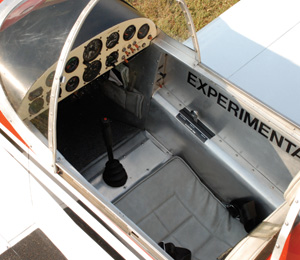
The side consoles make for an attractive, minimalist cockpit, with potential for a spectacular Art Deco design. The elevator trim knob location on the right console is less than optimal, however.
Dave Thatcher started the CX4 design after he retired. A long time A&P mechanic, Thatcher is in his late 70s now, and started the CX4 in his early 70s. He went from concept to flight in just a few years. “I originally built it for me, not the marketplace,” he says. “The marketplace has come to me.” His goal was an airplane that would be easy to build, economical, roomy and with a covered cockpit.
Just Cleco and Pop Rivet? Almost
Peter Beck of Kentucky now sells CX4 kits. He learned of the CX4 through an ad in this very magazine. He constructed a set of spars, sent them to Thatcher for approval, and soon became the airframe kit purveyor. Beck is enthusiastic about the CX4, and he ought to know a good design when he sees one. His parents had sent him not to MIT, but instead up the river to Harvard where he majored in astrophysics. After a career in high-tech management, he enjoys manufacturing and selling the CX4 kits.
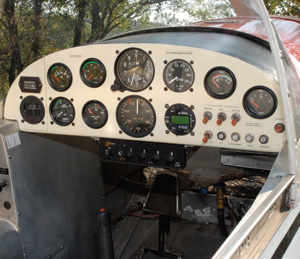
The small number of steam gauges is appropriate to the mission and character of the CX4. Glideslope and synthetic vision are certainly not required.
We caught up with Beck and the prototype CX4 at the Lee Bottom fly-in in southeast Indiana, on a flat just above the Ohio River across the river from Kentucky. This was the Wood, Fabric and Tailwheels fly-in—no airshow events, no traffic pattern fly-bys, just folks talking airplanes with those similarly afflicted. My restored Cessna 175 has fabric seats, so I figured I qualified.
Beck showed two CX4s there. One was the prototype, in an attractive paint scheme designed by Thatcher, and another was an airframe under construction that was complete enough to show the design. You can build from plans, or you can purchase kits and components.
Modern Pre-Assembly
The idea of the kits is that all of the critical work will be done for the builder to reduce errors—exactly what many of today’s kit builders expect. Spars are pre-assembled in the kits. Much, but not all, of the CX4 airframe is available from Beck with the rivet holes CNC-punched to final size. The fuselage and wing panels— excluding the very outer wing panels—can be Clecoed and riveted out of the box for instant progress. Most of the aluminum is corrosion-resistant 6061, almost as strong as and cheaper than 2024, which most airplanes use for their sheet-metal pieces. Mainspar caps are 1.5-inch angle, 3⁄16 inch thick, but the spar cap doublers in the inboard portions of the wing panels and in the center section are 2024, ¼ inch thick. The tapered and upswept wingtips are not pre-punched, and they require conventional aluminum construction techniques.
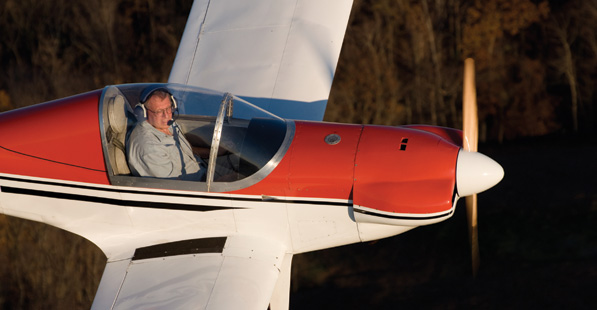
Visibility from the cockpit is obviously wonderful.
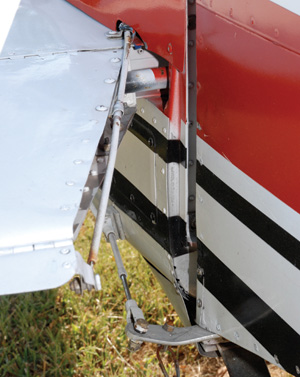
The rudder is controlled with dual push-pull cables, providing redundancy should one fail. The other cable controls elevator trim.
Economics drove the design. Thatcher says a CX4 can be airborne for less than $14,000, including engine, and that seems reasonable. If you choose to buy all of the available pre-manufactured parts, plan to double that, and if you want full-glass EFIS, dual WAAS, backup gyros and flush rivets—well, you’re probably looking at the wrong airplane.
The mission of the CX4, as Beck explains it, is a Saturday morning pancake breakfast airplane, and I think he’s right. The CX4 is fast enough to keep up with the Cessna 172s, it can carry 25 pounds or so of baggage, and while you could fly it on a long cross-country, that would be more of necessity than desire. The CX4 doesn’t have an instrument panel big enough for a lot of widgets, nor a large gas tank, nor enough payload for the other accoutrements of the cross-country set. Unless you put in a big honkin’ engine, a Sport Pilot can fly it without a medical.
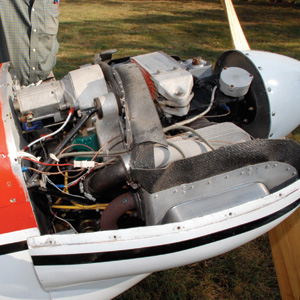
The Great Plains engine. An engine-driven fuel pump that would normally be at the front of the engine has been removed for a smoother cowl contour.
The Thatcher web site shows pictures of the completed (and painted) prototype being static tested. The structure has been tested to normal category, 3.8 positive G, with a 50% safety factor above that. However, no flutter tests have been performed. The ailerons do not have mass balances to alleviate flutter, and that lowers redline airspeeds. The aircraft has not been spun, but eyeball engineering suggests that with the long tail arm and ample vertical tail, including below the horizontal tail, spins should not be a problem. After we discussed these points, Beck asked me if I wanted to spin it. “Not for free,” I said.
Beat the Wind
On this Friday morning, a big front was coming in from the west, and winds ahead of the front were frisky—only 10 mph on the surface, more at the ridgetops. But at 3000 feet, winds were forecast at 42 knots, and forecast for winds at 25 minutes after takeoff was 15 gusting to 25. With the local topography, gust effects were likely to be multiplied. There was time for a quick flight, but best not to tarry.
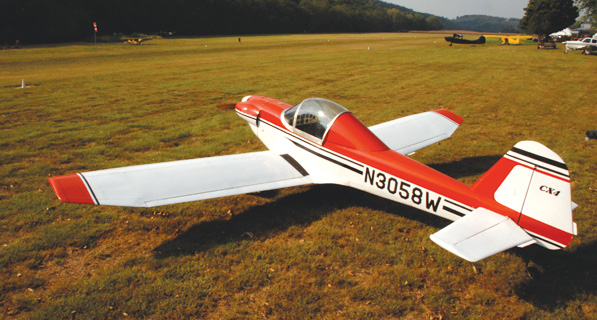
The CX4 has the field to itself; 24 hours later, some 400 airplanes had assembled here.
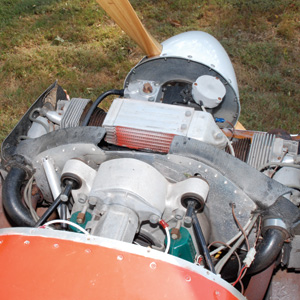
Atop the engine is the oil cooler. Note the cutout in the rear engine baffle so oil cooler exhaust air has an exit route.
The cockpit is huge, relatively speaking, with excellent headroom and legroom, and good shoulder room. All of the controls are where you would want them, except maybe the elevator trim knob on the right console. If you wanted to trim off pressures, you’d have to either reach across with your left hand or feel the pressures with your left hand on the stick and then trim them with your right.
Taxiing was easy on the grass runway, and you could almost see over the nose, which is pretty good for a taildragger; there was great visibility to each side. Runup was simple—trim, ignition, fuel pump on, controls free and, most important, make sure the canopy is latched. You can fly with it open, but you wouldn’t want it to slide open spontaneously on your first takeoff.
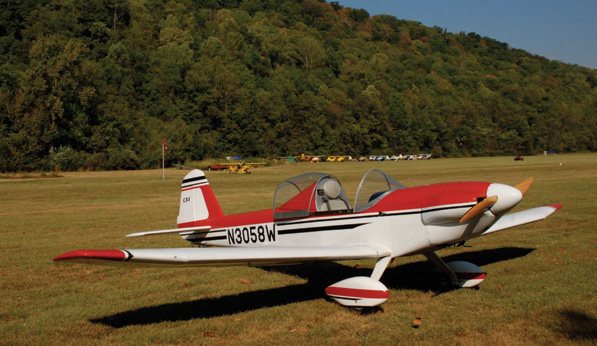
Clear skies, an expanse of smooth grass and a cute airplane. What more could a pilot ask for?
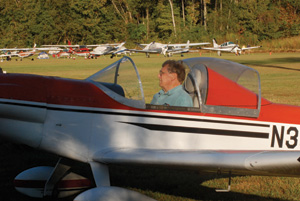
Peter Beck taxies out in the CX4 for a photo run. Note that in the background, the airport has filled up with fly-in guests.
With traffic in the pattern nonexistent, I turned onto the grass runway and slowly advanced the throttle. Takeoff acceleration and climb were moderate with the small propeller and the 56-horsepower, VW-derived engine. Whether it was the crosswind from the left, inadequate left rudder inputs (the propeller turns the “wrong” way), or the CX4 getting light on the wheels while too slow for crosswind ailerons to take effect, the plane drifted off centerline before getting airborne. Then, 10 feet up, the fun started.
The air over the runway was mean-spirited, encouraged by irregular terrain mimicking a canyon, which made for a goodly challenge in an unfamiliar airplane. Forewarned of light controls, the challenge was manageable, but the winds were messing with me big time. I bounced my head off the canopy more than once on climbout.
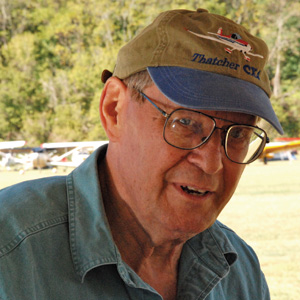
Beck sells major kit components for the CX4 and arranges demo flights. About 30 different pilots have flown the prototype so far.
The Futile Hunt for Smooth Air
Climbout was at 80 mph indicated, and the turn from upwind to downwind showed a heap of winds aloft. The ride was better than I would have expected with the light wing loading (10 pounds per square foot), the small size of the airplane and the expected turbulence. There was abundant heat in the cockpit, and I looked vainly for a heater to turn off or a vent to open. (Back on the ground, I discovered that there is a vent, and it was open, but it was downstream of the engine cooling air exiting the cowling chipmunk cheeks. You would want to think up something better than this on your own version.)
The 1736cc Great Plains engine necessitated rudder correction during climb, and the rudder feel was nicely light but not too much so. The rudder pedals were reachable but farther forward than I would have liked, easily fixed with a seat cushion. This airplane felt easy to coordinate, though there was no skid ball to point out any shortcomings and no other pilot on board demanding a bribe to keep his mouth shut.
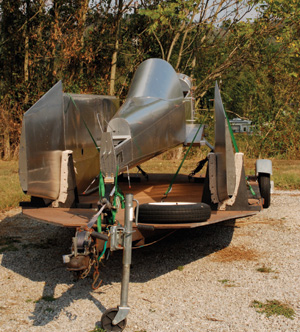
This structure is quickly built with much of the kit pre-punched. The finished plane is easily trailered as well.
Leveling off, I turned off what I thought was the auxiliary fuel pump and watched the fuel-pressure gauge. To my surprise, the fuel pressure headed toward circulatory collapse, recovering quickly as I turned the pump back on. Here was a detail unique to this engine installation—the carburetor requires fuel pressure, and there is no engine-driven pump. Turning off the electric pump or losing electrical power might precipitate a power loss; what I thought was the auxiliary pump was actually the main pump. There is a backup electric pump in this airplane, but in the hurry to get airborne, this detail had been missed. Why no engine-driven pump? Thatcher says that on many VW conversions, the engine-driven fuel pump sticks up out of the front corner of the engine and requires an ugly bump in the cowling for clearance, the electric-only setup.
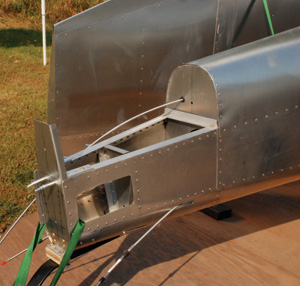
Pop rivets are easily visible in this close-up of the fuselage aft end. Note the elevator trim and rudder push-pull cables.
This detail, in turn, leads us to the history of VW conversions. In the early days, there were numerous failures until the industry learned how to convert the engines properly. After a while, the popularity of these engines waned, lessons were forgotten, and the failure rates crept back up. Now there are reputable vendors such as Great Plains and others, but don’t assume you know everything you should if you do your own conversion from scratch.
Beck reports a cruise speed of 110 mph at 2900 rpm, but given the turbulence and the time pressure, I was satisfied to measure the speed runs at 105 mph indicated. The GPS in reciprocal directions showed 79 and 117 knots, for a 98-knot average speed under less than optimal conditions, or 113 mph. Your mileage will undoubtedly vary with the choice of engine and prop. Still, that’s certainly respectable performance on this horsepower.
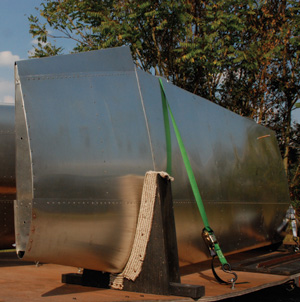
A wing panel, showing the straight inboard section (except for aileron taper) and the strongly tapered wingtip.
Polite Handling Characteristics
Next were slow Dutch rolls, holding a constant heading while slowly banking left and right, which was surprisingly easy. The ailerons had a nice feel, and things worked out better in the turbulence than in many other airplanes. Following those were fast Dutch rolls, using rudder and aileron in phase to rapidly roll from 45° bank, side to side, and these also worked well.
The ailerons and elevator are controlled with push-pull tubes, and the rudder is controlled with dual push-pull cables. Normally the rudder cables pull, but if one comes loose, you still have some amount of control.
Pushing right and then left rudder got the nose to swing side to side, but that damped commendably in only two full cycles. This confirmed the reason for the CX4’s good ride in turbulence even though it is small and light, two characteristics that normally increase susceptibility to such things.
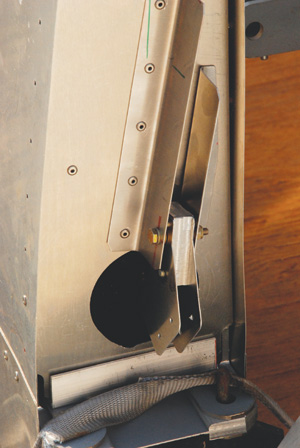
Spar cap doublers are among the few 2024 aluminum pieces. Note also the aileron pushrod bellcrank.
Knowing that the surface winds were about to pick up, I hurried through the rest of the abbreviated test program. At the 80-mph approach speed, slowing to 70 mph took about 2 pounds of pull on the stick, enough that a sensitive pilot would not inadvertently get too slow on approach as might happen in a plane with lighter stick forces. In the frisky air, there was no point in attempting any stick-free stability tests.
A 2-G turn took 4 pounds of stick pressure, a little on the light side for airplanes whose missions include cross-country and weather-be-damned travel, but not necessarily out of line for this class of VFR-only airplane. However, I did employ all of the aileron rolling into the turn, and did not get the sparkling roll rate I expected. The apparent explanation is that the CX4 ailerons don’t go all the way out to the tips, have limited chord and are tapered to boot.
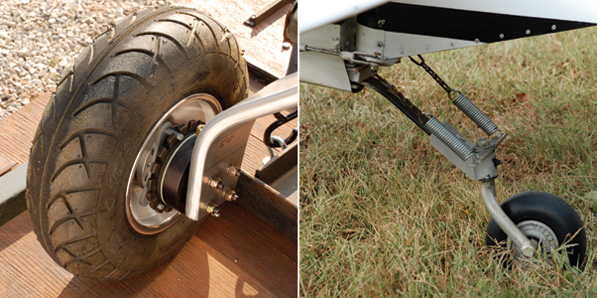
Left: The 5.00×5 Azusa wheels and hydraulic brakes are standard. Right: The tailwheel is fully steerable and will break loose and swivel for sharper turns.
That roll rate is, I think, appropriate for this airplane, which is not intended to be aerobatic, even though the cockpit design would bring out the Walter Mitty in the meekest of us. The limited aileron power is an appropriate thwartage of any lurking yank-and-bank instincts, including those of former RV-4 owners like me. In any case, the controls have a great feel and harmony.
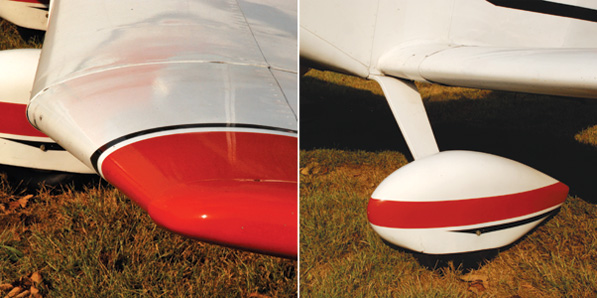
Left: Swept back and slightly upswept wingtips add to the dihedral effect. Right: The tidy paint scheme on the CX4 was designed by Thatcher, who also does custom paintings of airplanes (for hanging on your wall, that is).
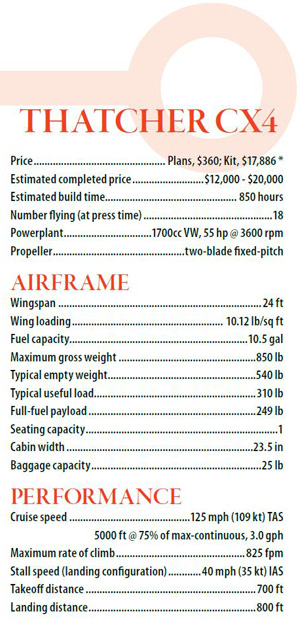
Specifications are manufacturer’s estimates and are based on the configuration of the demonstrator aircraft. As they say, your mileage may vary.
With the Cub airfoil (USA 35B), the CX4 stalled, you guessed it, like a Cub. With power off, you could hear the impending stall, and both power-on and power-off stalls had a pronounced softness in the stick, negligible buffet and a slight roll off onto the left wing. Then again, I didn’t have a skid ball and I might have had too much left rudder in at the break. Nah, not with my skills. No way.
Smooth Landings and Shark Attacks
With the ugly winds forecast to start in 5 minutes—not that a Flight Service forecast guarantees meteorological punctuality—it was time to get back on the ground. Pattern speed was 80 mph and easy to hold, and short final was recommended as 65. The airspeed was only back to 75 when ugly turbulence and gusts on base leg convinced me to forget about the 65 part and concentrate on alignment, drift and attitude. I did all that, and then there was this rumbling noise like three wheels on a grass runway, the result of 25 minutes of stick time and maybe a little dumb luck. I’m told that the landing was in a perfect (and relatively flat) three-point attitude. The CX4 tracked the centerline easily, and if there was any aileron power deficiency, it didn’t show up on this landing.
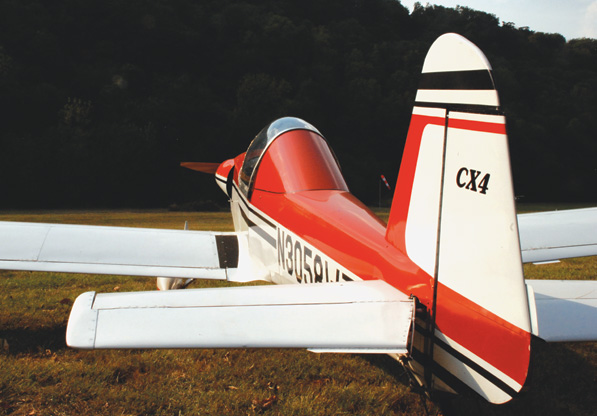
Generous vertical tail size and a long aft fuselage contribute to the freedom from excessive fishtailing in turbulence.
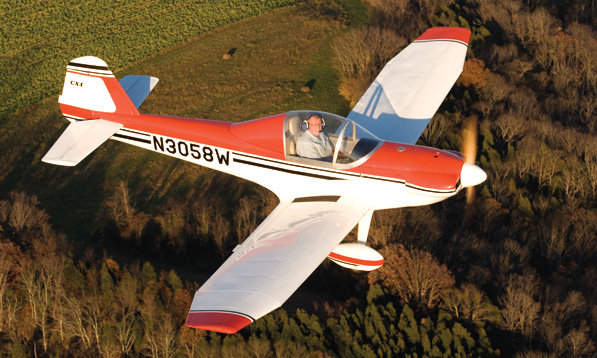
There is plenty of headroom under the big bubble canopy, even if you sit tall in the saddle.
Turns out that getting on the ground was a good idea. Not long after, roiling winds turned sadistic, and some pilots and airplanes barely rose to the challenge. One vintage taildragger ballooned, then landed on one wheel hard enough to taxi in with a list to port and a squealing ELT. A bunch of us sat on the sidelines and watched any number of Cessnas land fast with full flaps—go figure—as we scored the landings. Somebody commented that the only qualification for judging was experience judging shark attacks. I was glad my first CX4 landing preceded the more seriously challenging conditions.
Supposedly the first statement made by one test pilot right after completing the initial flight in a CX4 for a client, was: “Do you want to sell it?” That about sums it up. The CX4 appears to be an excellent choice for those who are looking for an inexpensive ride in a gentleman’s airplane.
For more information, call 850/712-4539 or visit www.thatchercx4.com.


